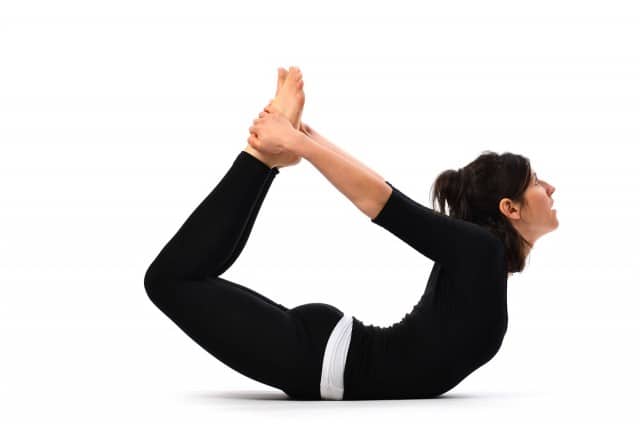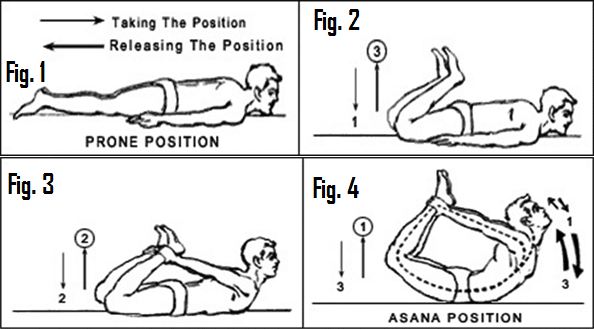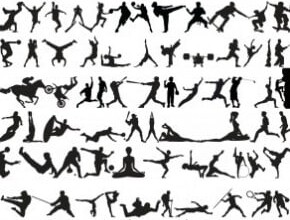 [adrotate group=”1″]This article describes in great detail how to do, step-by-step instructions, benefits, indications, contraindications, variations and accounts in ancient texts of bow pose or dhanurasana.
[adrotate group=”1″]This article describes in great detail how to do, step-by-step instructions, benefits, indications, contraindications, variations and accounts in ancient texts of bow pose or dhanurasana.
This posture can be a part of your everyday yoga practice. You can use it also in different sequences with other yogic postures. Dhanu means “bow” in sanskrit and asana means “pose”. That is how its name is formed.
- How to do dhanurasana and step-by-step instructions for bow pose
- Benefits of dhanurasana or bow pose
- Contraindications of dhanurasana or bow pose
- Modifications and variations of dhanurasana
- Easy variations and props for bow pose
- How to deepen dhanurasana
- Accounts in ancient texts of bow pose or dhanurasana
- How to do asanas
How to do dhanurasana and step-by-step instructions for bow pose
Here are step-by-step instructions on how to do yogic bow pose or dhanurasana. This is not a strict pattern and you may modify it according to your tastes and inner feelings. The only criteria of the right pose is harmony when you do it and not a rigid set of rules or some picture of a yogi in that asana. So, improvise and become a bow for a little while. 
- Lie prone on your yoga mat with your feet hip-width apart. Lay your arms alongside your body.
- Bend your knees and grab your ankles with your hands.
- Inhaling, lift your chest off the floor, pull your feet higher and backwards.
- Look at a point in front of you. Or you may look wherever you want. It doesn’t really matter.
- Now your body resembles a taut bow.
- Take a couple of breaths as is comfortable to you. Pay attention to your back and waist. There shouldn’t be any discomfort or pain.
- After some time exhale, slowly bring your legs and chest down to the floor.
- It may be 5 seconds or a couple of minutes depending on the condition of your body. [adrotate group=”2″]
Benefits of dhanurasana or bow pose
Benefits and positive effects of dhanurasana may be different for different people. Every person has his/her uniquely designed body. And bow pose as well as any other yoga asana may give different results depending on the person who performs it. If you are a child it may give one thing, if you are an elderly person it may give something else. But here is short list of most likely results.
- Strengthening of your back and abs.
- Stimulating of your reproductive organs.
- Opening up of your thorax, neck and shoulders.
- Toning of your whole body, especially of your legs and arms.
- Your back will be more flexible.
- Relief of menstrual pains and constipation.
- It might help with kidney problems.
It’s quite possible that this pose will help you with something else that is not listed above. Also it might not help you with some disorders and you should practice it with other poses. As many people there are as many dhanurasans exist. So, it is not possible to list all benefits of this posture. Therefore in different books and on different websites its positive effects differ a little.
Contraindications of dhanurasana or bow pose
Depending on a person contraindications for bow pose as well as any other pose may vary a little. But one thing is sure, you should take dhanurasana with great caution. Use common sense and don’t overstretch and overbend your body.
[adrotate group=”3″]Inner peace and harmony is the only guide worth following. The following list is just a thing worth taking into consideration and not a strict set of don’ts.
- High or low blood pressure.
- Hernia.
- Neck injury.
- Lower-back pains.
- Headache.
- Migraine.
- Abdominal surgery.
- Pregnancy.
The best way to know contraindications to a certain pose is to ask a doctor or a yoga-instructor who has a medical degree. Even yogis damage themselves who do not follow the principles of inner harmony and common sense while doing a certain asana.
If you have a disease mentioned above it doesn’t mean that you are forbidden to practice this pose. You may take a simplified version with the permission of a doctor. But anyway be careful.
Modifications and variations of dhanurasana
If it is difficult to do bow pose you may use its different modifications and variations.
Easy variations and props for bow pose
Here are some variations you can try in dhanurasana.
- You may just grab your ankles without bending too much towards the ceiling. You may do it without lifting your thighs and chest off the floor.
- You can wrap a strap around your ankles and hold its free ends.
- You may extend your arms or you may strain them a little as comfortable and pleasing
How to deepen dhanurasana
There are plenty of ways how to deepen bow pose. Your imagination and capability to improvise is the only limit.
- You can lie on your side instead of your stomach
- You can grab your toes
- You can grab your calves
- You can bring your knees together so that they touch each other
- You can grab just one foot and extend the opposite arm towards the wall in front of you.
It is just an approximate pattern and you can make your own asana. As many peope there are as many asanas exist. It is just a direction where to search for it.
Accounts in ancient texts of bow pose or dhanurasana
If you search for dhanurasana in ancient texts or any other pose you will be surprised to find that their description is very short, laconic and terse. There are no ten-page-long descriptions of any pose. Here are just a few examples. पादाङ्गुष्ह्ठौ तु पाणिभ्यां गॄहीत्वा शरवणावधि | धनुराकर्ष्हणं कुर्याद्धनुर–आसनमुछ्यते || २७ || pādāngghuṣhṭhau tu pāṇibhyāṃ ghṝhītvā śravaṇāvadhi | dhanurākarṣhaṇaṃ kuryāddhanur-āsanamuchyate || 27 || Meaning: Holding both the toes of the feet from both the hands, bring them upto the ear imitating a stretched bow, is called Dhanurasana. (Hatha-Yoga Pradipika 1.27)
This variant sometimes is called urdhva dhanurasana (upward bow) or ardha cakrasana (half-wheel pose). prasArya pAdau bhuvi daNDarupau karau ca pRSThe dhRtapAdayugmaM | kRtvA dhanurvatparivaritAGgaM nigadyate vai dhanurAsanaM tat || 18 “Stretch the legs out on the ground like a stick, extend the arms, hold both feet from behind with the hands, and make the body curved like a bow. [adrotate group=”4″]
That is called Dhanurasana” (Gheranda-samhita 2.18) “Place your body on the stomach and bend your knees. Grab the ankles by your hands and remain in this position for some time. Wait until the energy of this pose wakes up. Then start unbending your knees and bend the back. So you’ll take a bow pose. Remain in it until your body lets you.
This is unsurpassed pose to whet vital spirit. Life infirmity, weak vital spirit is cured by this pose. Shoulders and joints are cured by this pose. A lot of negative karma is burnt by it.” (Hatha-yoga narrative) Another description is found in bRhad-yoga-sopanam (3.22) “citation required“ As you can see in the ancient texts one asana maybe called by different names and many different asanas may bare the same name. The step-by-step instructions on how to do dhanurasana in this article are taken from gheranda samhita, bRhad-yoga-sopanam and the Hatha-yoga narrative.
How to do asanas
If you want to do asanas and avoid injuries you have to follow very simple but important rules. First, you have to understand that every treatise gives us an approximate picture of an asana. It is not a strict code that everyone must obey. Or you might find a picture of a yogi twisted into three knots. It doesn’t mean that he is doing that pose right and you do it wrong.
Looking exactly like a guy in the picture or strict performance of an instruction in a book is not the criteria of the “right” asana. The Hatha-yoga narrative tells us what the right pose is. “Adya asked: What should I beware of, when studying hatha yoga, to avoid any mistakes during practice? The girlfriend replied: – Be careful of your laziness, avoid downward thoughts.
The principles of yoga comprehension are the following. The first principle is the principle of perfection. The second one is the principle of the energy. The principle of perfection is: no matter how you are doing yoga exercise, you are doing it perfectly well, even if it does not look exactly as it was prescribed to do.
[adrotate group=”5″]The fact of doing the exercise makes it perfect by itself, and you will get better each time when you are doing it. It is an intermediate perfection. In time you will reach unchanged final perfection.” That is why the expression «to do exercise incorrectly» is meaningless.
The most important thing is to practice regularly and for a long time and be sure that in your own Universe at this moment of time and in these circumstances you do the asana perfectly. The principle of energy says that in the same way as a small ball in the funnel will always roll down the neck, when we do any asana the energy itself transforms the body. There is no need to worry about doing it correctly.
The main thing is to reproduce the pose, by doing it honestly, for a long time and regularly. Wake up the energy and the energy will do the yoga. So, become an artist and create your own asana. Harmony and common sense will guide you. There should be no pain in an asana. That’s all for now.
Don’t forget to write in the commentaries below how to improve this article. What do you think is missing and what is unnecessary. Share it with friens if it was useful. Also don’t forget to visit the website of Lonavla Yoga Institute (lonavalayoga.org). With their kind permission citations from different ancient treatises are provided.
These quotes make this article stand out among hundreds of similar articles. Lonavla Yoga Institute’s kind support made this text unique and exclusive so that you all might enjoy it and use in you daily yoga practice.








